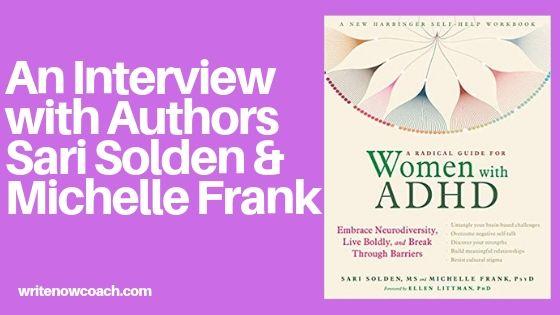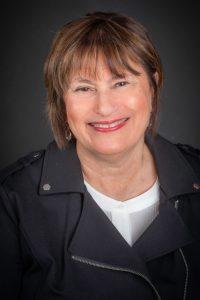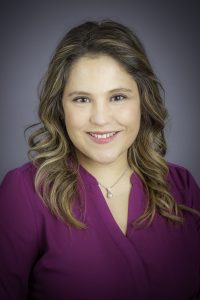Writers@Work: An Interview with the authors of A Radical Guide for Women with ADHD
July 9, 2019
Note From Rochelle
Dear Writers,
I’ve been living without internet or phone service since July 1—and not by choice. Whenever I have a spare moment, I run to the library or coffee shop to catch up on email and social media. If you’ve tried to contact me, and I haven’t responded—this might be why. Please try again.
Today’s blog post is an interview with Sari Solden and Michelle Frank, authors of the brand new book, A Radical Guide for Women with ADHD: Embrace Neurodiversity, Live Boldly, and Break Through Barriers. They will appear at Boswell Book Company on July 18 at 7:00 PM. If you live in the Milwaukee area, join them!
Enjoy!
Rochelle

Writers@Work: An Interview with Sari Solden and Michelle Frank
Authors of A Radical Guide for Women with ADHD
By Rochelle Melander
Welcome to the blog! Can you tell us about your new book, A Radical Guide for Women with ADHD: Embrace Neurodiversity, Live Boldly, and Break Through Barriers?
Sari Solden: The book is called a Radical Guide for Women with ADHD because it is based on the “radical” but simple idea that instead of trying to fix herself, a woman with these kinds of challenges can simply learn to be herself. Women with ADHD internalize the culture’s gender role expectations about what it means to be a good enough woman and when their executive function challenges of ADHD collide with these idealized images, these women hide who they are. They feel they must forfeit their rights to meaningful relationships and fulfilling contributions. We encourage them to learn to walk alongside of their challenges rather than being engulfed by them or overwhelmed by their shame-based narrative.
Michelle Frank: Our book is based on the premise that breaking through shame and self-limiting beliefs is crucial to living well with ADHD. This begins with the process of untangling from the shame-based narratives most women with ADHD have carried around all their lives. Many will tell you, “I just thought it was me, with tons of character flaws.” This sort of internalized blame is very destructive and wholly unnecessary. We propose that you can learn to be more of yourself, not less. That by unlinking your brain-based challenges from your character, by rewriting your beliefs about yourself, and by practicing new thoughts and behaviors you can support your ADHD challenges while also living a big, bright, and bold life. To date, many resources for people with ADHD focus on minimizing symptoms, and they neglect the whole person.
What led you to write this book?
Sari Solden: We share the same perspective about empowering women with brain- based challenges. We approach our clinical work in very similar ways. We both believe in seeing these women whole instead of viewing women through a lens of pathology.
Our clinical work with women with ADHD led us to a place of wanting to change the conversation in the field to move away from the heavy emphasis on strategies and tools to include the concept of valuing neurodiversity and self-acceptance. We wanted to design a program that women could work through with their own therapist or on their own, to take them through the same process that we take our clients through as they go through this process we call untangling. The first book I wrote called Women with ADHD, published in 1995, was about ADHD itself and the shame women with ADHD feel. This book is more about the woman herself.
Michelle Frank: We wrote the book that we wish we, ourselves, had when navigating our own personal journey with ADHD and also to validate and guide our clients. We wanted a book that addressed the emotional legacy of ADHD, the shame and hiding and disconnection that can emerge during a lifetime of living with invisible differences. We also wanted a book that speaks to women’s unique experiences of living with ADHD because they are still underrepresented.
We’ve found that doing the deep dive of uncovering sources of shame and rebuilding sense of self is incredibly important to living well with a chronic condition like ADHD, and the book follows that premise. It goes deeper than basic strategies, which are certainly necessary but not sufficient to success with ADHD. The women we know who live well with ADHD aren’t necessarily the ones who have the perfect time management or organizational system; they are the women who have a strong sense of self, ask for what they need, and view themselves as whole rather than broken or a series of deficits.
What are some tools that you use to help women overcome the challenges that ADHD presents regarding productivity?
Sari Solden: We think of productivity through a broader lens for these women. The question for her is, how to redefine what it means to be a successful person and woman, how she can make a valuable contribution even though she has challenges with traditional measures of productivity. We find that creating a compelling vision to move toward is a much better approach than just trying to get over who you are. We find that accepting yourself with your challenges allows a woman to build on her strengths instead of just focusing on what’s wrong. We encourage women not to wait until everything is done, not to focus exclusively on tasks, but on designing an authentic and meaningful life.
Michelle Frank: Education and validation are incredibly important to the process of living well with ADHD, and so often I start there. I then work with women with ADHD to identify their values, strengths, and passions and take a look at how those things are related to their unique challenges and how to build supports and systems that are individualized to their needs. We tend to work a lot on asking for help and tolerating healthy doses of vulnerability, since many people with ADHD are sensitive to the slightest possibility of rejection after years of experiencing judgment, stigma, and shame. We also process old wounds and shame triggers, learn how to work through shame spirals and separate core sense of self from ones’ challenges and old stories, and how to begin to open up to life more.
Women with ADHD tend to pull back from life as they spend all of their resources trying to manage their challenges. We’ve found this is corrosive to truly supporting those challenges. The more you focus on trying to get rid of something, trying to be someone other than yourself, the more you end up magnifying the obstacles and limiting the opportunities. So I work with my clients on stepping out of their comfort zone, expanding their view of themselves and their challenges, becoming more authentic and present, and how to lean into the life in front of them rather than pull away.
I find that negative self-talk can be a really challenging issue for my clients. What tools have you found to be helpful in supporting clients in dealing with the inner critic?
Sari Solden: Finding someone who can truly see you whole, value your strengths and see your possibilities, gives you permission to focus on your hopes and dreams and re-awaken old dreams. With this support you can develop the courage to move to the edge of your comfort zone and have one new small successful experience of yourself. You can begin to slowly build on this and develop a new cycle of success and a new self picture. This is what helps you reverse the negative self-talk so you can develop a new story about yourself.
Michelle Frank: How we talk to ourselves matters! We use language to make sense of our world, so it follows that the language we choose and use repeatedly will shape our perception of ourselves, others, and the world around us. So we are constantly working with our clients on noticing detrimental self-talk and shifting to a more compassionate voice. This isn’t just feel-good fluff either; the work of Kristen Neff has empirically proven the power of self-compassion.
Research in psychology also tells us that it helps to become the observer of our experiences, rather than stay put in the position of the talker and feeler. For instance, thinking “I am a failure” is more powerfully negative than curiously noticing, “I am having the thought that I’m a failure. Something is triggering me.” In the former example, you completely fuse with the thought and the feelings that come with it. There’s no room for separation or action. You’re all thought spiral and emotion. In the latter, you are the observer, which means you have greater capacity to pause, be curious about what’s going on, and make an intentional choice in what you say to yourself next or what action to take. From this space, you can practice using a more compassionate tone with yourself, identify a possible trigger, and decide what you could do for yourself that would be helpful instead of hurtful and sabotaging in that moment. Continuing down the spiral of shaming and critical self-talk will only hold you back.
What was it like to write a book together? Do you have any advice for our readers?
Michelle Frank: Hard! We wrote this book in one voice, which is rare and incredibly difficult to do well, but we think we aced it! Though it wasn’t easy, it was a very rewarding process because we were able to process everything we were writing about, everything that was coming up for us, together. We began to use some of the techniques we talk about and practice them together.
My advice in this area would be: If you’re going to write a book with someone else, make sure it’s someone that you can be open, honest, and vulnerable with. Make sure you are talking about what’s coming up for you and ask for help when things are getting hard, and make sure to communicate directly about your vision, needs, and process.
Sari Solden: We have complementary skills and challenges so we’re able to fill in each other’s gaps and work back and forth through a lot of content and with a lot of structure. We had a good editor who kept us that track but who was flexible with us.
If you want to write a book, get someone to help you. Don’t think you can do everything yourself—whether it’s editors or someone to help fill in particular gaps or someone to listen to what you want to say and help you organize your thoughts and bring them to life. Everybody’s got strengths and challenges.
Write something you want to talk about for a long time to come. That’s advice I got before I wrote my first book. You will be talking about it for many years. So don’t pick a topic just because you think it is marketable. Write something that comes from your heart, that’s authentic, that you are passionate about or ideas you want to give as a gift to other people.
You are busy professionals—how did you find time to write?
Michelle Frank: Both the hard part and the beauty of being in private practice is that you make your own schedule. So I set aside days where I didn’t see clients at all, only worked on the book. I also worked a lot of nights and weekends. A lot of them. #coffee
Sari Solden: We found time to write together because we were working in the same space. We had to create a lot of structure. We had to create specific times to meet and to send our chapters to each other. So working together made it less likely to procrastinate! We could structure times but then be flexible with each other- when one person wasn’t able to do something that week by a certain time, the other person picked up the slack and vice versa.
Also we were each other’s cheerleaders when we needed to be!
What are you reading now?
Sari Solden: I’m reading Mary Piper’s Women Rowing North. It’s about women who are getting to be around the age 70 and all the challenges that they face in terms of keeping their selves engaged and alive and making adaptations. This is building to the next stage for people who are for the first time experiencing memory challenges or differences or difficulties.
And so I can apply everything that I’ve learned all these years about memory challenges of women with ADHD to women who are aging and just beginning to learn to need support and modify the way they do things to keep being who they are!
Michelle Frank: Right now I’m reading a hilarious, impactful, and moving book called Maybe You Should Talk to Someone by Lori Gottleib. I savor every chapter! I recently finished Where the Crawdads Sing, by Delia Owens, and loved it. The other books I’m reading (since tend to have a pile by my bed), are on things like epigenetics and how our environment impacts our gene expression, nutrition for optimal brain and body health, and gardening in Colorado! Oh, and I’m also in love with A Radical Guide for Women with ADHD: Embrace Neurodiversity, Live Boldly, and Break Through Barriers…it got great reviews! 😉
About the authors

Sari Solden, M.S, is a psychotherapist who has counseled adults with ADHD for 30 years. She is the author of Women with Attention Deficit Disorder, Journeys Through ADDulthood, and co-author of A Radical Guide for Women with ADHD (July 2019). She serves on the professional advisory board of ADDA and was received their award for outstanding service by a helping professional. Her areas of specialization include women’s issues, inattentive ADHD, and the emotional consequences and healing process for adults who grew up with undiagnosed ADHD. She is a prominent keynote speaker on these subjects nationally and internationally.

Dr. Michelle Frank is a clinical psychologist specializing in providing diagnostic and treatment services to individuals with ADHD. When not working directly with clients, Dr. Frank is committed to writing and speaking on issues of ADHD, neurodiversity, and empowerment. She is co-author of the upcoming book for women with ADHD entitled A Radical Guide for Women with ADHD: Embrace Neurodiversity, Live Boldly, and Break Through Barriers.









Hi, I’m an ADHD coach — diagnosed in my fifties — and I’ve already purchased this book. I’m finding it to be very readable and a resource I hope to use with clients.
I was surprised, therefore, to come upon a quotation in the book from Dr. Thomas E. Brown, a very well-known “expert” on ADHD, that includes the word “impairments” twice in defining ADHD. This, to me, is one of the most poisonous words out there, frequently used by old-style researchers in referring to the ADHD brain. I feel that this word goes against the entire spirit of the book; and, since it appears very early on (in the “A Note to Our Readers”), it sets a negative tone in what otherwise seems to be a very positive book. While the one quote doesn’t negate the good that this book can do, viewing the ADHD brain as impaired is wounding, from an ADHD-er’s point of view. It supports the notion of “disability” rather than “difference,” and steers the reader toward the negative concept of neural deficit rather than the positive perspective of neurodiversity. A sharp editor should have flagged it, and recommended that a different quote be used, in my opinion, because people with ADHD are often hypersensitive to criticism.
For those with ADHD, so much depends on creating an environment that supports oneself, rather than accepting the “givens” of a culture that insists that we conform to neurotypical standards. Part of that culture is the insistence that ADHD folks are “impaired.” But the Brown quote is a small glitch in what otherwise appears to be an excellent contribution to the literature geared toward women with ADHD. I especially recommend the list of “Duh! Messages” on page 39. These are the glib one-liners that constitute the bulk of advice given to people with ADHD. Thanks for this, Solden and Frank — glad I’m not the only eye-rolling ADHD-er out here.